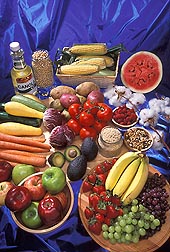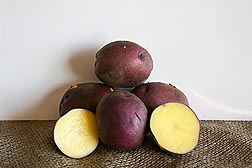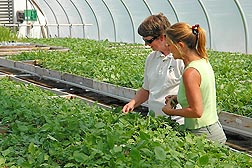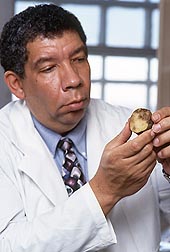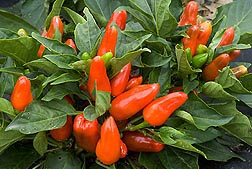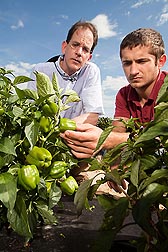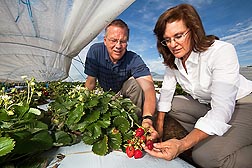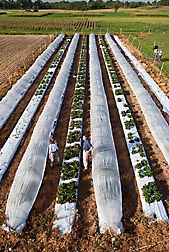Fruits and Veggies for Now and in the Future
|
|
Fruits and vegetables are important parts of a balanced diet, and making sure consumers have an abundant supply of them is part of the Agricultural Research Service’s mandate.
Genetic improvements in fruits and vegetables are essential to meet the ever-changing needs of growers, processors, and consumers. Scientists in ARS laboratories around the country strive to meet those needs.
Potatoes—a Kitchen Staple
In Beltsville, Maryland, plant geneticist Kathy Haynes is breeding potatoes with higher levels of carotenoids. Haynes, who is with the Genetic Improvement of Fruits and Vegetables Laboratory (GIFVL), in cooperation with nutritionist Beverly Clevidence, who is with the Food Components and Health Laboratory, is developing yellow potatoes with higher carotenoid levels for fresh consumption. In the July 2011 issue of the Journal of the American Society for Horticultural Science, Haynes describes the plant crosses she used to double and triple carotenoid levels normally found in Yukon Gold potatoes, a yellow-fleshed variety familiar to consumers.
Several carotenoids are involved, including neoxanthin, antheraxanthin, violaxanthin, lutein, and zeaxanthin. Of these, lutein and zeaxanthin are of keen interest for eye health; they appear to protect against age-related macular degeneration and, perhaps, cataract formation.
|
|
“Zeaxanthin is the one I am most interested in at this point because there are fewer sources of it in the diet than lutein. Both lutein and zeaxanthin are very high in dark-green leafy vegetables like spinach and kale—vegetables that people don’t tend to eat a lot of,” says Haynes. “My thinking is that if we can elevate their levels in potatoes, which people do eat a lot of, then we could make a significant impact on the human diet.
“We have a new potato named Peter Wilcox, which is a purple-skin, yellow-flesh potato introduced in 2007,” says Haynes. “It is being grown a lot for use in roadside-market niches. The overall carotenoid levels in that potato are about 15 percent higher than they are in Yukon Gold potatoes.”
More recently, Haynes and her colleagues have, with help from wild potatoes, produced a potato that has even higher carotenoid levels. The potatoes most people can purchase in the grocery store are tetraploids, meaning they have four sets of chromosomes. Most wild potatoes are diploids, possessing two sets of chromosomes, and are often small and lumpy, unlike the potatoes consumers purchase.
“What we found in the diploids is that those with intense yellow flesh have about 13 times more carotenoids than Yukon Gold. So we thought we would be able to cross them with tetraploid potatoes to produce potatoes that have 13 times the carotenoid levels and look like grocery store potatoes. But it didn’t happen that way,” explains Haynes. “We ended up with tetraploids that have only 2-3 times the carotenoids present in Yukon Gold potatoes—not what we were hoping for. Still, the carotenoid levels are higher than in current varieties on the market.”
|
|
Protecting Spuds From Their Enemies
Potato plants can be damaged or killed when they don’t recognize an attack by pests and fail to initiate responses to defend themselves. Identifying protective genes and deploying them in modern cultivated potatoes will help ensure a secure future for potato production, benefiting producers and consumers.
Plant pathologists Rick Jones, Ken Deahl, and Leslie Wanner, also at GIFVL, are focusing on resistance to Phytophthora late blight and Streptomyces scab. Jones and collaborators identified key Phytophthora enzymes involved in late blight during studies of the Phytophthora genome. That work was recently published in Nature. Jones continues to study individual gene functions of both Phytophthora and potato to determine the best way to protect potatoes from this devastating disease.
|
|
“Identifying individual protective genes in potato enables their direct introduction into already popular varieties such as Russet Burbank, avoiding extensive breeding and selection efforts,” Jones says.
“In 2011, we isolated and characterized a population of newly occurring strains of Phytophthora from tomato and potato hosts growing in heavily blighted fields in several locations in the United States. This information will be useful to plant breeders who need to test plant material for susceptibility to these new strains,” says Deahl.
The group also looked at potato cultivars and characterized them for resistance to common scab. Caused by several species of Streptomyces, common scab of potato is a persistent problem for growers. “Identifying plant resistance is difficult, partly because complex populations of multiple Streptomyces strains are usually present in production fields. Breeders typically screen for resistance in fields with multiple common scab-causing strains, but strains typical for one part of the country differ from the strains typical for a different geographic region,” says Wanner. “In order to strengthen scab-resistance breeding efforts, we successfully characterized three potato families for resistance to common scab in greenhouse assays using individual pathogenic Streptomyces strains typical of different parts of the country.” This information will be helpful to potato breeders in their efforts to incorporate resistance into new cultivars and is now available online to select potato cultivars for growth in specific regions (tinyurl.com/potatoscab).
At the Vegetable Crops Research Unit in Madison, Wisconsin, plant physiologist Paul Bethke, geneticist Shelley Jansky, and technician Andy Hamernik are working on a phenomenon called “cold-induced sweetening,” which causes sugar accumulation during long-term cold storage and results in unwanted dark colors in fried and roasted potatoes. Long-term cold storage is necessary to supply potatoes throughout the year.
Bethke, Jansky, and Hamernik used a recently developed technology to show that decreasing the activity of one key enzyme—invertase—is sufficient to enable cold storage of potatoes without compromising the appearance of potato chips or the growth characteristics of the potato plants.
“We are using molecular tools to improve our understanding of what is controlling the process of cold-induced sweetening. We know potatoes are sensitive to their environment and highly sensitive to low temperatures. Potatoes respond to the cold by producing certain sugars called ‘reducing sugars,’ primarily glucose and fructose,” says Bethke. “When you make chips or fries from those potatoes, they tend to be dark colored and bitter—traits people don’t want. In our paper in Plant Physiology, we provide a proof-of-concept that the invertase enzyme is critically important in the process.”
However, it has never been clear how important, because there are other biochemical steps that might also contribute, Bethke says.
“We found that if you prevent the invertase gene from being expressed and therefore prevent the protein from being made, there is an accumulation of sucrose and a corresponding reduction in the amount of glucose and fructose in tubers stored at very low temperatures.”
|
|
A Pack of Peppers
At GIFVL, geneticist and research leader John Stommel is developing peppers to have a dual purpose—culinary and ornamental—for use in a high-value niche market. Stommel and his colleague Robert Griesbach, now with the ARS Office of Technology Transfer, are not strangers to the arena of developing novel peppers, having produced Tangerine Dream, Black Pearl, and Lil’ Pumpkin, among others.
“One of our first releases, Tangerine Dream, which preceded the All America Selections award winner Black Pearl, is a dual-purpose culinary ornamental,” says Stommel. “Tangerine Dream is orange, banana shaped, and about 3 inches long.”
Tangerine Dream was passed along to Burpee Seed Company through the team’s cooperative research and development agreement (CRADA) partner, Pan American Seed Company. “It is a fun-looking plant that grows prostrate, with green foliage and attractive, upright-oriented, orange fruit,” says Stommel.
|
|
“We are also working on miniature bell peppers for dual culinary and ornamental use. Plants have black or green foliage and cherry-tomato-size bell peppers, which we believe will be very popular for the home garden and commercial specialty markets,” he says.
Pepper flavor is also under the research scope for Stommel and his colleagues. Under a CRADA, Stommel has been working with Keygene Inc. (Rockville, Maryland), for the last 4 years. “We are working to identify genes that can impart fruity flavors in pepper. We’ve made some crosses between sweet pepper and some exotic species of pepper that have very unique fruity aromatics,” says Stommel. “We are producing a value-added commodity—a sweet green pepper with the aromatics of ripe red or orange fruit. This exotic species of pepper we identified embodies unique floral aromatics at the green stage, which is very unusual, and we are working to introduce that into cultivated sweet pepper.”
The green bell pepper, which is the immature form of the yellow, orange, and red pepper, dominates the market in the United States and South America. Green peppers with new flavors could be a boon to the vegetable industry.
Bountiful Berries
Also at GIFVL, geneticist Kim Lewers is striving to improve strawberries and is conducting field trials in several states under materials-transfer agreements with collaborators. While Lewers’s focus is on yield, fruit quality, and disease resistance, she is testing some of those strawberry cultivars in a new production system designed to extend the growing season in the northern and eastern United States.
Strawberry is the highest value-per-acre crop that can be grown in this country, but most strawberries are grown in California and Florida. Lewers would like to expand the crop’s range to more locations.
“I am trying to make strawberries available locally all along the East Coast, as much of the year as possible, with as little pesticide residue as possible, and we are developing a production system that supports that,” says Lewers. “Common strawberry diseases that can affect yield and quality are mainly Botrytis and anthracnose. In our research fields, we use no fumigants and no fungicides, and our program is known for disease resistance. The soils in our Beltsville fields have a natural population of microbes after a decades-long period with no fumigants and fungicides. Because we don’t use anything to protect our strawberries, we know that if they still survive and do well it’s because they are resistant or tolerant.”
In an effort to extend strawberry production beyond the normal local strawberry season of mid-May to mid-June, Lewers, along with ARS colleagues John Enns, a horticulturalist, and George Meyers, with Research Support Services, created a production system that uses low tunnels to cover the rows of strawberry plants.
|
|
These tunnels provide a long row of shade and rain protection. Rain is bad for strawberries because the two most important diseases, Botrytis and anthracnose, thrive in the rain. Botrytis occurs in cool, wet conditions, and anthracnose occurs in hot, wet conditions.
“This tunnel system has evolved. We have various sensors that measure environmental factors inside and outside the tunnels, such as temperature and relative humidity,” explains Lewers. “High tunnels have been used by others, but they were problematic because the humidity is higher in the tunnel, which causes more Botrytis and more powdery mildew, another strawberry disease. But in low tunnels, the humidity is the same as outside the tunnel when the sides of the tunnel are up—a good thing because that doesn’t facilitate disease under the tunnel.
“The Maryland peak strawberry season is usually mid-May to mid-June, but our strawberries start earlier and continue through the summer and fall. So we have a whole new season. Monthly yields in the low tunnels can be as high as those from the same cultivars when they are grown in California, where they were developed.”
All of the strawberry plant material developed in Lewers’s research program has been and still is freely available. The plants are not patented, so they are available without special license to any nursery that wants to grow them.
|
|
“These are truly a gift to the taxpayer and the industry. Also, our material is known for having better flavor. Growers call it the ‘eastern’ flavor, and some California breeders now request our material and expertise about selecting cultivars that would impart different desirable traits,” says Lewers.
Another berry—the black raspberry—has been the subject of ARS researchers at the Horticultural Crops Research Unit in Corvallis, Oregon, and at Oregon State University. ARS horticulturist Chad Finn and colleague Michael Dossett, of Agriculture and Agri-Food Canada, are the first to find and report resistance in black raspberry to the large raspberry aphid. The duo screened seedlings from 132 wild populations of black raspberries for aphid resistance.
“Strong resistance was found in three of these populations—one from Ontario, one from Maine, and one from Michigan,” says Finn. “Aphid resistance in the Ontario and Maine populations is dominant and seems to be controlled by different genes. Aphid resistance in the Michigan population is governed by one dominant gene.” A trait is dominant when it can be inherited from only one of its parents and still be expressed.
“Identifying these genes makes it easier for breeders to incorporate aphid resistance into commercial black raspberry cultivars,” says Finn.
|
|
Black raspberry production is severely affected by the black raspberry necrosis virus, which is transmitted by the large raspberry aphid. This and other aphids are important vectors of viruses in raspberry in North America.
“Although breeding for aphid resistance has been recognized as an important tool for protecting red raspberries from viral infection, this is the first report of aphid resistance in black raspberry,” says Finn.—By Sharon Durham, Agricultural Research Service Information Staff.
This research is part of Plant Genetic Resources, Genomics, and Genetic Improvement (#301), Plant Diseases (#303), and Crop Protection and Quarantine (#304), three ARS national programs described at www.nps.ars.usda.gov.
To reach scientists mentioned in this story, contact Sharon Durham, USDA-ARS Information Staff, 5601 Sunnyside Ave., Beltsville, MD 20705-5129; (301) 504-1611.
"Fruits and Veggies for Now and in the Future" was published in the October 2012 issue of Agricultural Research magazine.







